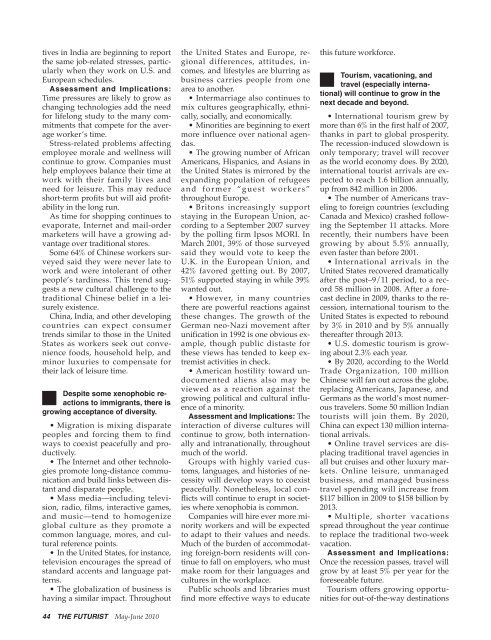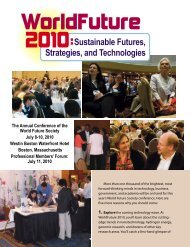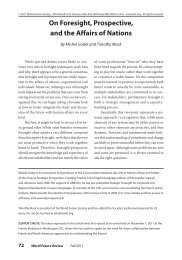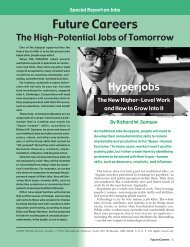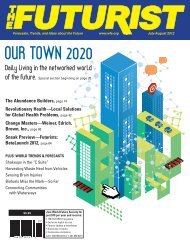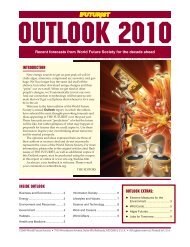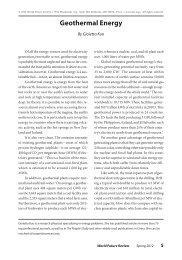Trends Shaping Tomorrow's - World Future Society
Trends Shaping Tomorrow's - World Future Society
Trends Shaping Tomorrow's - World Future Society
You also want an ePaper? Increase the reach of your titles
YUMPU automatically turns print PDFs into web optimized ePapers that Google loves.
tives in India are beginning to report<br />
the same job-related stresses, particularly<br />
when they work on U.S. and<br />
European schedules.<br />
Assessment and Implications:<br />
Time pressures are likely to grow as<br />
changing technologies add the need<br />
for lifelong study to the many commitments<br />
that compete for the average<br />
worker’s time.<br />
Stress-related problems affecting<br />
employee morale and wellness will<br />
continue to grow. Companies must<br />
help employees balance their time at<br />
work with their family lives and<br />
need for leisure. This may reduce<br />
short-term profits but will aid profitability<br />
in the long run.<br />
As time for shopping continues to<br />
evaporate, Internet and mail-order<br />
marketers will have a growing advantage<br />
over traditional stores.<br />
Some 64% of Chinese workers surveyed<br />
said they were never late to<br />
work and were intolerant of other<br />
people’s tardiness. This trend suggests<br />
a new cultural challenge to the<br />
traditional Chinese belief in a leisurely<br />
existence.<br />
China, India, and other developing<br />
countries can expect consumer<br />
trends similar to those in the United<br />
States as workers seek out convenience<br />
foods, household help, and<br />
minor luxuries to compensate for<br />
their lack of leisure time.<br />
■<br />
Despite some xenophobic reactions<br />
to immigrants, there is<br />
growing acceptance of diversity.<br />
• Migration is mixing disparate<br />
peoples and forcing them to find<br />
ways to coexist peacefully and productively.<br />
• The Internet and other technologies<br />
promote long-distance communication<br />
and build links between distant<br />
and disparate people.<br />
• Mass media—including television,<br />
radio, films, interactive games,<br />
and music—tend to homogenize<br />
global culture as they promote a<br />
common language, mores, and cultural<br />
reference points.<br />
• In the United States, for instance,<br />
television encourages the spread of<br />
standard accents and language patterns.<br />
• The globalization of business is<br />
having a similar impact. Throughout<br />
44 THE FUTURIST May-June 2010<br />
the United States and Europe, regional<br />
differences, attitudes, incomes,<br />
and lifestyles are blurring as<br />
business carries people from one<br />
area to another.<br />
• Intermarriage also continues to<br />
mix cultures geographically, ethnically,<br />
socially, and economically.<br />
• Minorities are beginning to exert<br />
more influence over national agendas.<br />
• The growing number of African<br />
Americans, Hispanics, and Asians in<br />
the United States is mirrored by the<br />
expanding population of refugees<br />
and former “guest workers”<br />
throughout Europe.<br />
• Britons increasingly support<br />
staying in the European Union, according<br />
to a September 2007 survey<br />
by the polling firm Ipsos MORI. In<br />
March 2001, 39% of those surveyed<br />
said they would vote to keep the<br />
U.K. in the European Union, and<br />
42% favored getting out. By 2007,<br />
51% supported staying in while 39%<br />
wanted out.<br />
• However, in many countries<br />
there are powerful reactions against<br />
these changes. The growth of the<br />
German neo-Nazi movement after<br />
unification in 1992 is one obvious example,<br />
though public distaste for<br />
these views has tended to keep extremist<br />
activities in check.<br />
• American hostility toward undocumented<br />
aliens also may be<br />
viewed as a reaction against the<br />
growing political and cultural influence<br />
of a minority.<br />
Assessment and Implications: The<br />
interaction of diverse cultures will<br />
continue to grow, both internationally<br />
and intranationally, throughout<br />
much of the world.<br />
Groups with highly varied customs,<br />
languages, and histories of necessity<br />
will develop ways to coexist<br />
peacefully. Nonetheless, local conflicts<br />
will continue to erupt in societies<br />
where xenophobia is common.<br />
Companies will hire ever more minority<br />
workers and will be expected<br />
to adapt to their values and needs.<br />
Much of the burden of accommodating<br />
foreign-born residents will continue<br />
to fall on employers, who must<br />
make room for their languages and<br />
cultures in the workplace.<br />
Public schools and libraries must<br />
find more effective ways to educate<br />
this future workforce.<br />
■<br />
Tourism, vacationing, and<br />
travel (especially international)<br />
will continue to grow in the<br />
next decade and beyond.<br />
• International tourism grew by<br />
more than 6% in the first half of 2007,<br />
thanks in part to global prosperity.<br />
The recession-induced slowdown is<br />
only temporary; travel will recover<br />
as the world economy does. By 2020,<br />
international tourist arrivals are expected<br />
to reach 1.6 billion annually,<br />
up from 842 million in 2006.<br />
• The number of Americans traveling<br />
to foreign countries (excluding<br />
Canada and Mexico) crashed following<br />
the September 11 attacks. More<br />
recently, their numbers have been<br />
growing by about 5.5% annually,<br />
even faster than before 2001.<br />
• International arrivals in the<br />
United States recovered dramatically<br />
after the post–9/11 period, to a record<br />
58 million in 2008. After a forecast<br />
decline in 2009, thanks to the recession,<br />
international tourism to the<br />
United States is expected to rebound<br />
by 3% in 2010 and by 5% annually<br />
thereafter through 2013.<br />
• U.S. domestic tourism is growing<br />
about 2.3% each year.<br />
• By 2020, according to the <strong>World</strong><br />
Trade Organization, 100 million<br />
Chinese will fan out across the globe,<br />
replacing Americans, Japanese, and<br />
Germans as the world’s most numerous<br />
travelers. Some 50 million Indian<br />
tourists will join them. By 2020,<br />
China can expect 130 million international<br />
arrivals.<br />
• Online travel services are displacing<br />
traditional travel agencies in<br />
all but cruises and other luxury markets.<br />
Online leisure, unmanaged<br />
business, and managed business<br />
travel spending will increase from<br />
$117 billion in 2009 to $158 billion by<br />
2013.<br />
• Multiple, shorter vacations<br />
spread throughout the year continue<br />
to replace the traditional two-week<br />
vacation.<br />
Assessment and Implications:<br />
Once the recession passes, travel will<br />
grow by at least 5% per year for the<br />
foreseeable future.<br />
Tourism offers growing opportunities<br />
for out-of-the-way destinations


